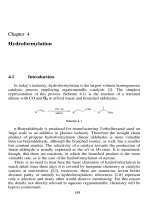Tài liệu Chapter 9: Monoprotic Acid-Base Equilibria pdf
Bạn đang xem bản rút gọn của tài liệu. Xem và tải ngay bản đầy đủ của tài liệu tại đây (4.32 MB, 43 trang )
Chapter 9:
Monoprotic Acid-Base Equilibria
Chapter 11:
Acid-Base Titrations
Example: Determination of
Example: Determination of
HCl
HCl
concentration by titration with
concentration by titration with
NaOH
NaOH
I. Solutions and Indicators for Neutralization Titrations
A. Standard Solutions:
The standards solutions used as titrants for unknown weak
acids or bases are always strong bases or acids, respectively.
Standard titrant acids: dilute solutions of HCl, HClO
4
, or H
2
SO
4
.
Standard titrant bases: dilute solutions of NaOH, KOH.
The primary
standards may not be strong acids or bases (e.g.,
potassium acid phthalate, sodium oxalate, sodium
bicarbonate).
B. The Theory of Indicator Behavior
1. pH-sensitive dyes have long been used as indicators.
Normally, the basic form (In) on the dye has a color different from the acid
form, HIn:
HIn + H
2
O <====> H
3
O
+
+ In
-
In + H
2
O <====> OH
-
+ HIn
+
][HIn
][In]OH[
Ka
3
−+
= [Eq.1]
][In
][HIn]OH[
Kb
+−
=
[Eq. 2]
We can see that both equilibrium constant expressions above can be written:
][In
]Ka[HIn
]OH[
3
−
+
=
[Eq. 1’]
][In
]Ka[HIn
]OH[
3
+
+
=
{Note: K
w
=K
a
K
b
= [OH
-
][H
+
]} [Eq. 2’]
Therefore, the [H
3
O
+
] determines the ratio of the acid/conjugate base form o
f
the indicator.
To see the color of a particular form (acid or base) of the indicator, that
form must be present at tenfold
higher concentration.
For example,
To see the color of acid form, the ratio [HIn]/[In] must be equal to or greater
than 10.
To see the color of base form, the ratio [HIn]/[In] must be equal to or less
than 0.1.
This means that:
For acid color [H
3
O
+
] > K
a
(10/1)
For base color [H
3
O
+
] < K
a
(1/10)
Hence: indicator range = pK
a
± 1, and the pH change in the area of the
equivalence point must match
this range or at least overlap it significantly
to use this indicator for endpoint detection. (note: how to select the
indicator)
9-1
C. Titration Curves – may be linear-segment curve or a
sigmoidal curve depending on what is plotted on the y-axis.
The X-axis units are always reagent or titrant volume.
The Y-axis may be in increments of analyte reacted or
product formed (linear-segment curve) or a p-function
such as pH (s-curve).
The equivalence point is characterized by large changes
in the relative concentrations
of the reagent and analyte.
(See Table 10-2)
Titration Curves
9-2
D. The Titration of a Strong Acid with a Strong Base
Example: Determination of
Example: Determination of
HCl
HCl
concentration by titration with
concentration by titration with
NaOH
NaOH
NaOH + HCl NaCl + H
2
O
moles = C
NaOH
V
NaOH
= C
HCl
V
HCl
1. H
3
O
+
in the titration medium has two sources
a. From the H
2
O solvent
b. From the acid solute - usually this is in great excess relative contribution from
water because the K
w
is so small
c. The mass balance equation describing this situation is:
[H
3
O
+
] = C
HCl
+ [OH
-
] = C
HCl
d. The same is true for a strong base and we can write:
[O H
-
] = C
NaOH
+ [H
3
O
+
] = C
NaOH
2. Before the equivalence point
We calculate the pH of the titration medium from the
concentration of unreacted
strong acid:
baseacid
3
3
VV
]OH[ of Moles]OH[ of Moles
]OH[
+
−
=
−+
+
pH = - log [H
3
O
+
]
3. At the equivalence point
All of the acid has reacted with the titrant base. For a strong acid
titrated with a strong base, the salt is a strong electrolyte and
therefore completely dissociated. It does not react with H
2
O. The
resulting solution is neutral (pH = 7.00) because:
HCl + NaOH <====> H
2
O + Na
+
+ Cl
-
2 H
2
O <====> H
3
O
+
+ OH
-
4. After the equivalence point
we calculate the pH of the titration medium from the concentration
of unreacted strong base:
baseacid
3added
3
w
VV
]OH[ of Moles]OH[ of Moles
]OH[
K
]OH[
+
−
==
+−
+
−
9-1
9-2
Any Questions?
5. The Effect of Concentration on the shape of the curve:
With a very dilute solution of strong acid which is titrated with
a very dilute solution of strong base, there will be a smaller
relative change in the pH immediately before and after the
equivalence point
6. The selection of an indicator
The indicator range (detectable color change) should
occur in the area of the equivalence point.
Concentration effect
i. titration of 0.0500 M HCl with 0.1000 M NaOH three
indicators (phenolphthalein, bromothymol blue,
Bromocresol green) have color changes in this
range.
ii. for the more dilute titration medium (0.000500 M HCl
with 0.001000 M NaOH), only one of the indicators
(bromothymol blue) is now suitable.
iii. This is because the relative pH change for the
second curve is so small that two of the indicators
change color before or after the equivalence point.
Any Questions?
E. Buffer Solutions:
A buffer solution resists changes in pH.
Buffers usually consist of a weak acid/conjugate base pair
mixture in solution.
Since the titration of a weak acid (or base) with a strong base
(or acid) will form a buffer solution, the curves constructed
for these titration systems will appear quite different from
those where all the reactants are completely
E1. The Calculation of the pH of Buffer Solutions:
Example: We are preparing a buffer in which the acid, HA, and its
salt, NaA, are being added to the solution to give C
HA
and C
NaA
For the species HA and A
-
we can write:
a. Pertinent Equilibria
HA + H
2
O <====> A
-
+ H
3
O
+
A
-
+ H
2
O <====> HA + OH
-
2H
2
O <====> H
3
O
+
+ OH
-
b. Equilibrium Expressions
][HA
]A][OH[
K
-
3
a
+
=
[Eq. 1]
][A
]HA][OH[
K
-
b
−
=
[Eq. 2]
K
w
=[H
3
O
+
] [OH
-
] [Eq. 3]
c. Mass balance equations:
[HA] = C
HA
- [H
3
O
+
] + [OH
-
] [Eq. 4]
[A
-
] = C
NaA
+ [H
3
O
+
] - [OH
-
]
[Eq. 5]
d. Approximations:
Since the concentrations of these species are likely to be
negligible relative the C
HA
and C
NaA
, we can approximate:
[HA] = C
HA
[A
-
] = C
NaA
This assumption is true only when K
a
< 10
-3
and the relative
concentrations of the acid or its conjugate base are relatively
high.
e. Solving equations
If we rearrange Eq.1 and solve for [H
3
O
+
] then
]A[
][HAK
]OH[
-
a
3
=
+
[Eq.1’]
Taking -log of both sides of Eq.1’
HA
NaA
a
-
a
-
a
C
C
logpK
]HA[
][A
logpK
]A[
][HA
logpKpH +=+=−=
This equation implies that the pH of a buffer solution is
independent of the dilution of the solution since the relative
concentrations of conjugate base/acid do not
change upon
dilution
HA
NaA
a
C
C
logpKpH +=
9-3
HCOO
-
+ H
2
O < ==> HCOOH + H
3
O
+
9-4
+
+=
4
3
NH
NH
a
C
C
logpKpH
+
+=
4
3
NH
NH
a
C
C
logpKpH









